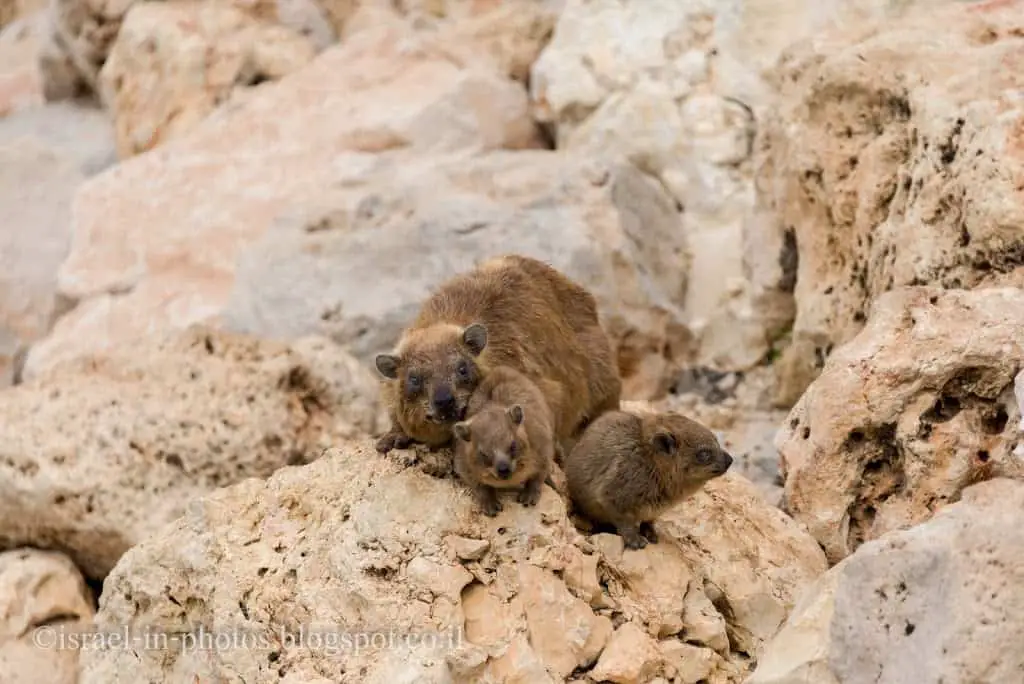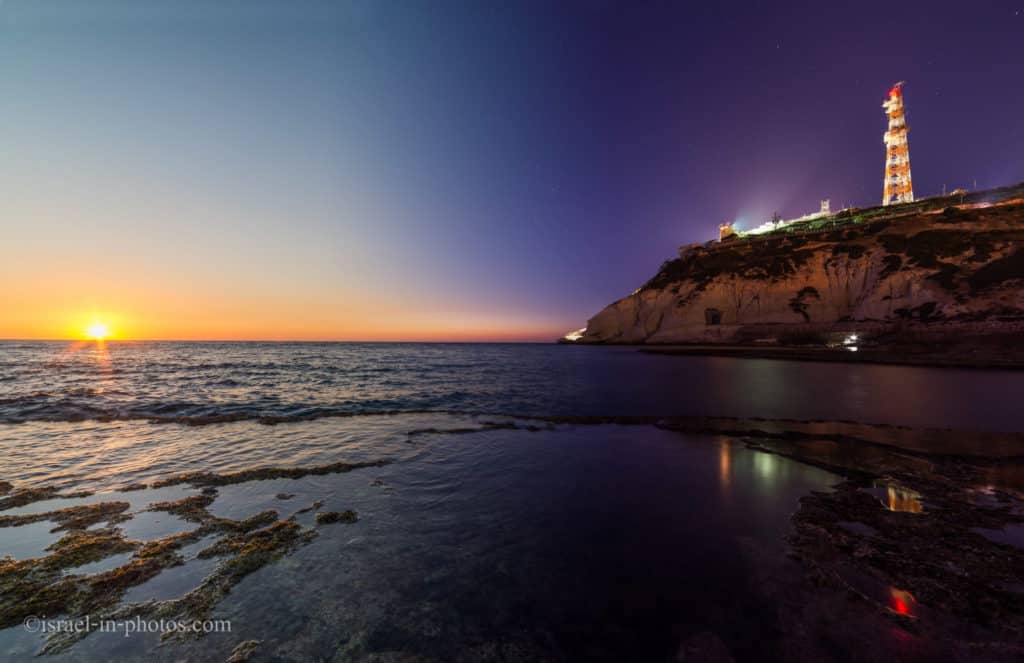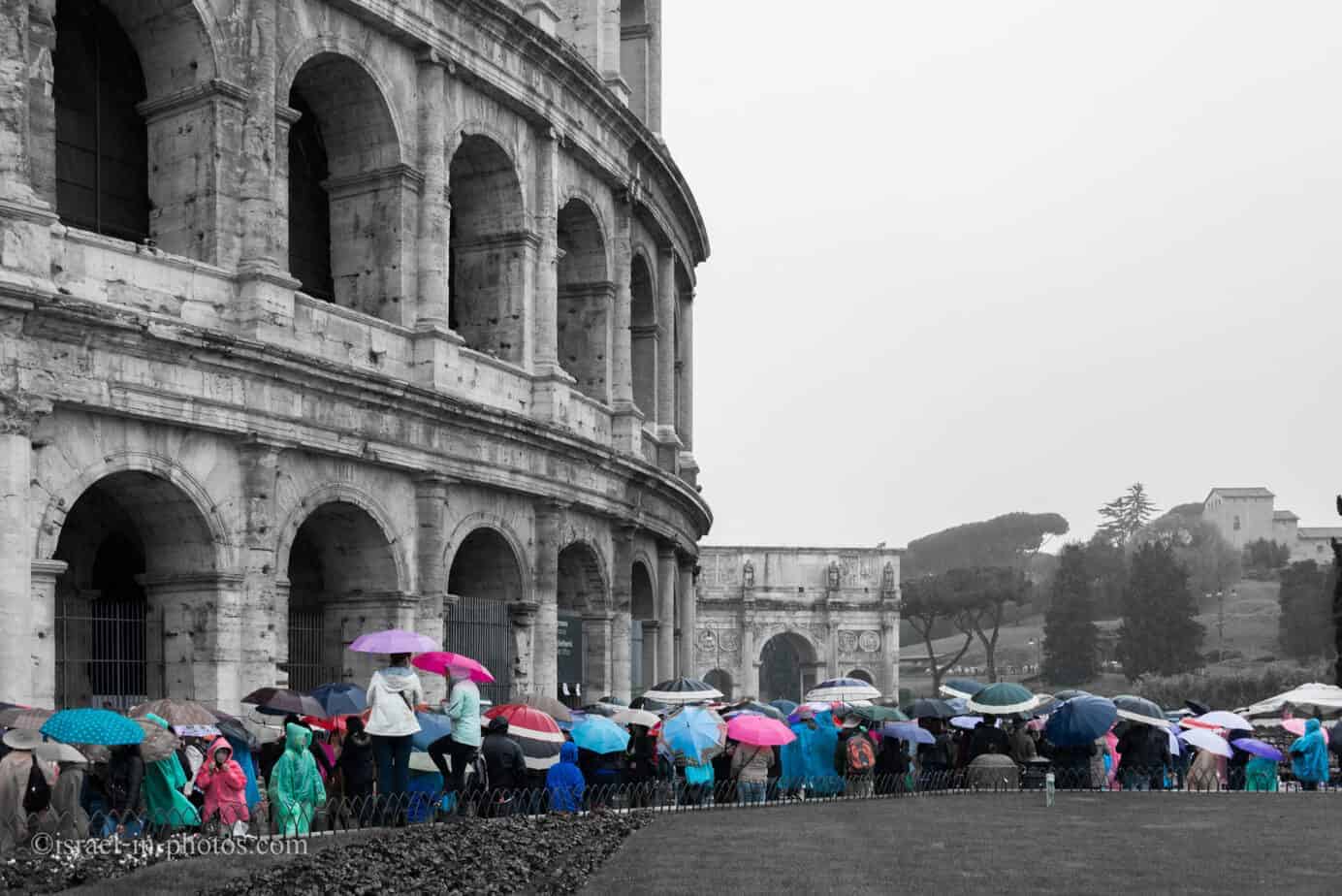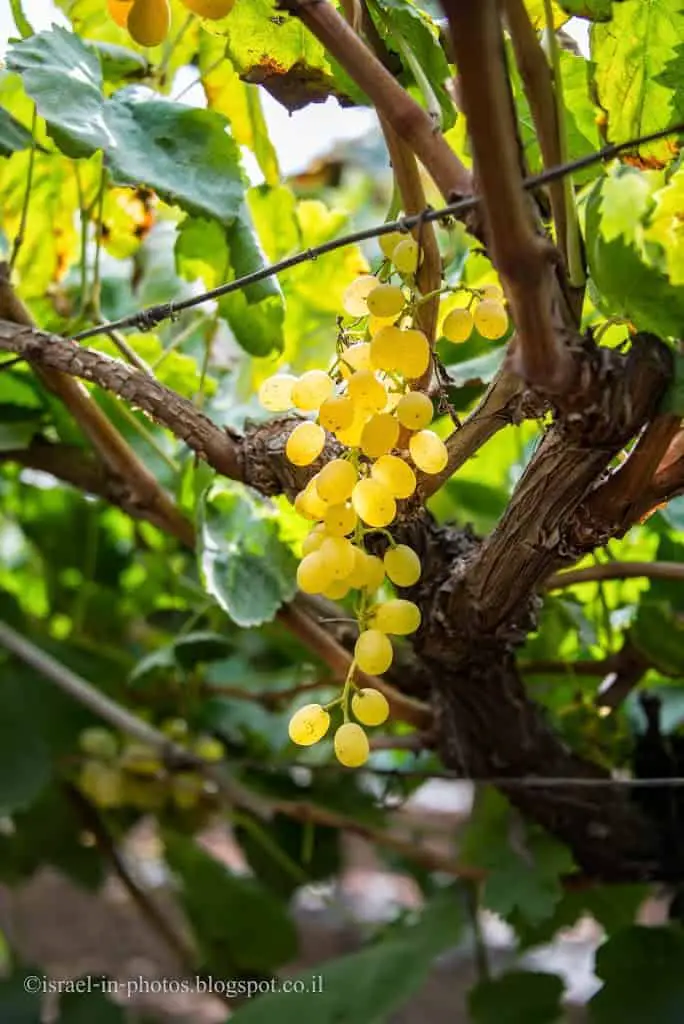Rosh HaNikra – Full Guide to Stunning Seaside Grottoes
Rosh HaNikra is a geologic formation near the border with Lebanon. Sea activity on white chalk rock formed the grottoes.
Table of Contents
- 1 Map
- 2 Directions
- 3 Parking
- 4 Opening Hours
- 5 Entrance Fee
- 6 Coupons
- 7 Tours
- 8 What does Rosh HaNikra mean?
- 9 Entrances
- 10 Cable Car
- 11 Audiovisual Presentation at Rosh HaNikra Grottoes
- 12 History
- 13 The Grottoes
- 14 Driving an Electric Golf Car at Rosh Hanikra Sea Reserve
- 15 Rock hyrax
- 16 Kayaking at Rosh HaNikra
- 17 Rosh HaNikra Islands
- 18 Rosh Hanikra Sea Reserve
- 19 Summary
Map
Rosh HaNikra is located north of Nahariya, north of Achziv National Park, and next to Lebanon’s border. Rosh HaNikra Grottoes is a white chalk cliff face that opens into spectacular grottoes. The nearby Achziv National Park has one of the most beautiful beaches in Israel. And I am mentioning both nearby attractions since you can combine them into a half-day visit. Also, the Rosh HaNikra village is nearby.
Directions for drivers: Link to Waze and Link to Google Maps
Directions for public transport: Link to Moovit
Interactive map of the area:
Directions
If you are reaching by car, drive along road #4 to the north. You will drive along the sea till you get to the end. You should see signs directing you to the grottoes as you approach closer.
Reaching by public transport is less convenient but also doable. First, you need to get to Nahariya. You can do this using buses or trains, depending on your location. Then, from Nahariya, you can take a taxi or bus #31. Here are the directions from Tel Aviv to Rosh HaNikra Grottoes using Moovit. You can also update Moovit with your starting point and get the revised instructions.
Parking
There are free parking spaces next to Rosh HaNikra Grottoes. But if you arrive later in the day (for example, after 11 am on a Saturday), there might be no free spaces at the parking lot. You can still park along the leading road, which will add to extra walking.

Note: As seen in the photo above, restrooms are in the far left corner of the parking lot.
Opening Hours
Sunday – Thursday: 09:00-18:00 (till 16:00 in the winter)
Friday: 09:00-16:00
Saturday: 09:00-17:00
Entrance Fee
Adult (18+) – 49 NIS.
Child (3 – 18) and pensioner – 39 NIS.
Babies and toddlers (0 – 3) – free.
Audio guide rental – 14 NIS.
There are several types of combined tickets. The first type offers a visit to Rosh HaNikra Grottoes and a bicycle or a golf car drive along the beach. It costs 77 NIS per adult and 69 NIS per child. The second combo ticket offers a combined ticket to Rosh HaNikra Grottoes and various attractions in Old Acre. If you want to visit the Templars Tunnel, Hospitaller Fortress (Knights Halls), Hamam al-Basha, and Treasures In The Walls Museum, it will cost 80 NIS per person.
Note: the combo tickets and the prices change from time to time. Thus, check the official site before visiting.
Coupons
If you purchase tickets at the official site, there will be a small discount (43 NIS per adult and 35 NIS per child). Here are additional coupons I found online:
- 1+1 at MAX (in exchange for a treat)
- cpnclub.co.il – 44 NIS per adult and 36 NIS per child. It is higher than the prices on the official site.
- Members of teachers association – 30 NIS per adult and 33 NIS per child.
Notes:
- Rosh HaNikra is not part of the Israeli National Parks Authority. Thus, a Matmon card will not provide any discounts.
- Opening hours and ticket prices were updated in July 2022. In any case, recheck the official site before visiting.
Tours
I just wanted to mention that Rosh HaNikra is a popular tourist site, and many firms offer tours. Usually, these tours include several nearby attractions, and this site is one of them. For example, Old Acre and Rosh HaNikra. If you are short on time or love traveling with tours, consider joining.
What does Rosh HaNikra mean?
In Hebrew, Rosh HaNikra means “the head of the grottoes,” in other words, the best Grottoes.
Entrances
The site has two entrances – the main, the upper, and the lower, next to the beach.
We came to the upper entrance. At the top entry, you can find a large parking lot. But since Rosh HaNikra Grottoes is a popular site, the parking may be full if you come later in the day.
Here is the view to the south of the beach, Nehariya, and Haifa:
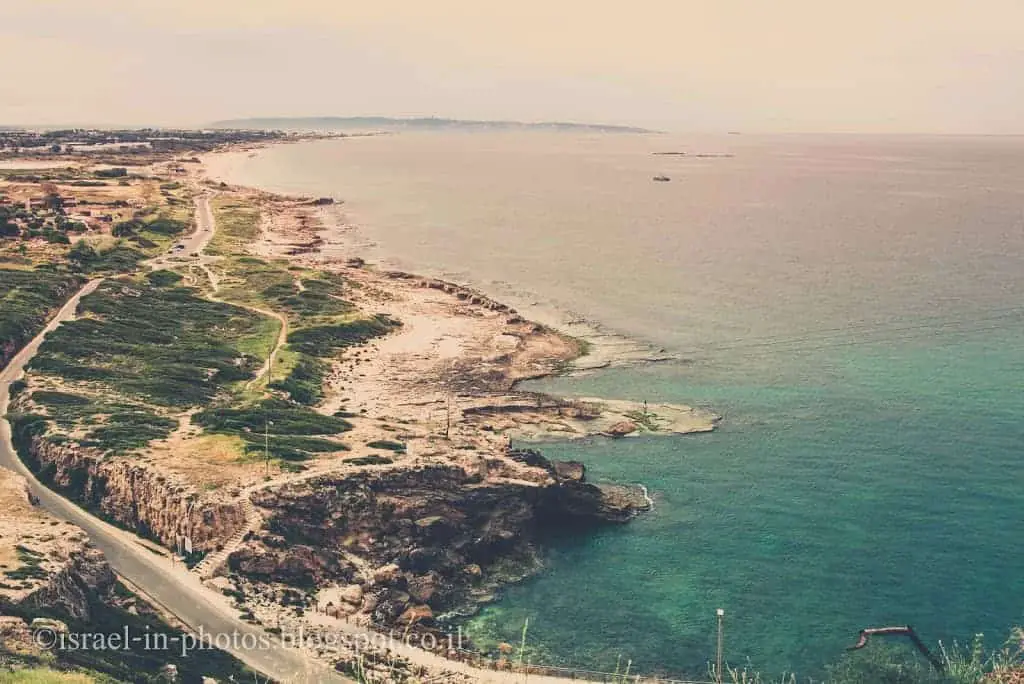


People usually associate crystal clear water with Greece, but some beaches in Israel look very similar to Greece. Achziv Beach and nearby ones are among Israel’s favorite and highest-ranking beaches.
Cable Car
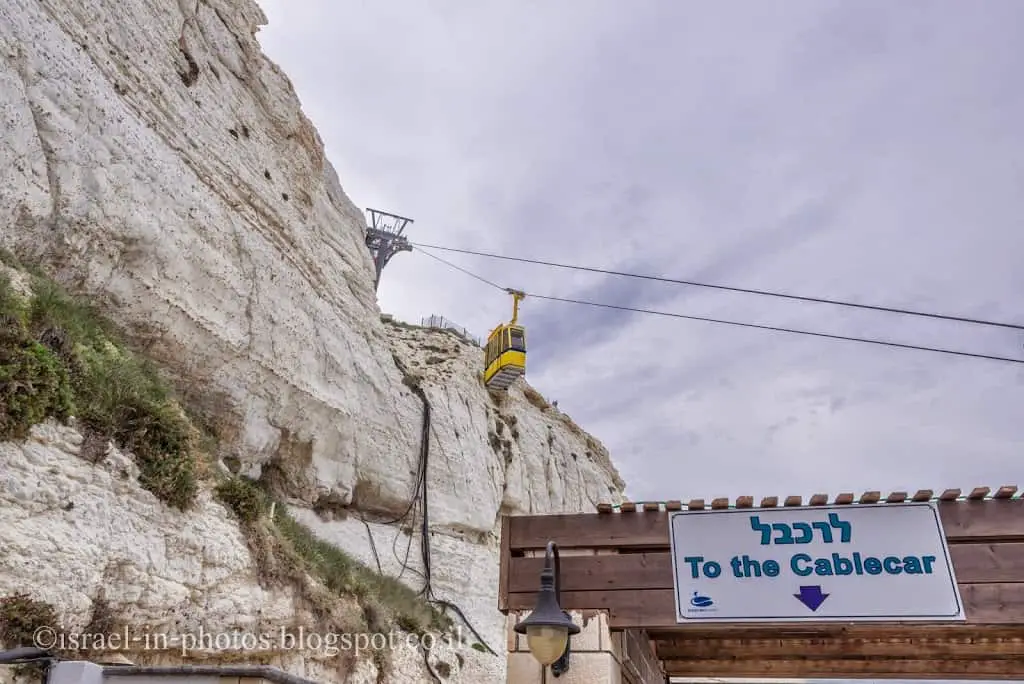
Reaching the caves from the top entry is done by cable car. They say it is the steepest cable car in the world (gradient of 60 degrees). But it is probably also one of the shortest ones. The ride takes about two minutes.
Also, since it is tiny (as far as I remember, the maximum capacity is eight people), I recommend getting to Rosh HaNikrah either early or late. Otherwise, you may get stuck in the queue for the cable car.
As you get off the cable car, you will see the following sign:

I suggest starting with the audiovisual presentation. To reach it, you turn left and go till the end.
Audiovisual Presentation at Rosh HaNikra Grottoes
After getting off the cable car, I recommend starting with the movie about this place. There is a screening every 15 minutes. And there are displays in different languages.
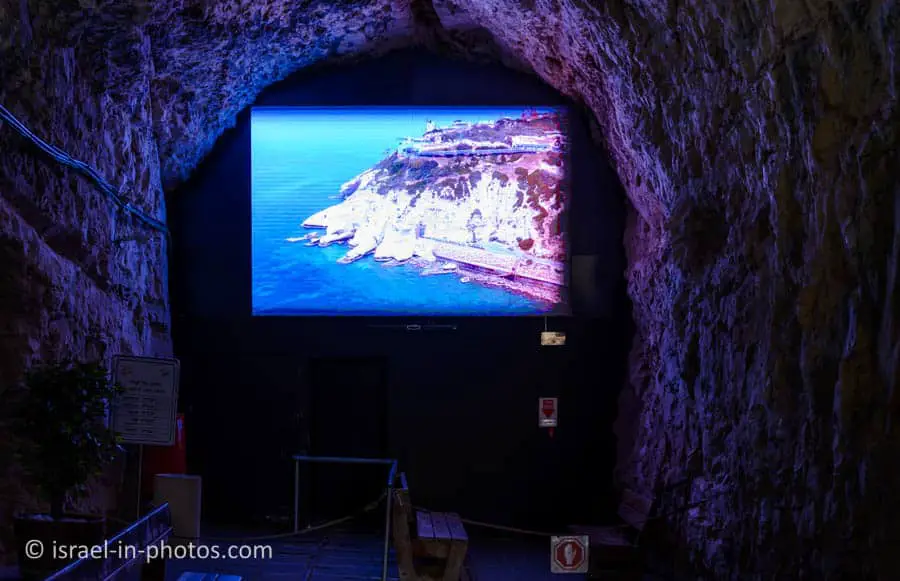
The film tells the history of this place and the geological history of the Grottoes. Plus, the story of the British Cairo – Istanbul railway.
History
The Book of Joshua mentions “Misraphot Mayim” as a place south of Rosh HaNikra that was the border of the Israelite tribes of the time. In the First Book of the Maccabees, it is referred to as the place that Shimon HaHashmonai was responsible for in 144BCE (1 Maccabees 11:59). Josephus Flavius also describes Rosh Hanikra as the northern border of the city of Acre, Israel. (The Jewish War 2, 10, 2). The archaeological tell is today situated within the kibbutz.
In the Jewish apocryphal First Book of Maccabees (1 Macc 11:59), a cape in this region is referred to as “The Ladder of Tyre.” The author could have meant either the cliffs at Rosh HaNikra or one of two other capes jutting out into the sea slightly north or south of them. The site was later named an-Nawakir (“The Grottoes”) by the Arabs.
Cairo-Istanbul Train

Rosh HaNikra has served as a passage point for trade caravans and armies between Lebanon, Syria, Israel, Egypt, and Africa. During the Second World War, South African forces blasted railway tunnels through the nearby rocks for trains running along the Cairo-Istanbul line. The Haganah spared the railway bridge at Rosh HaNikra during the 1946 Night of the Bridges operation. But following a late-1947 British announcement that it would withdraw from Palestine months ahead of schedule, the bridge was destroyed by the 21st Battalion under the Palmach in late February 1948 to hinder Lebanese arms shipments to Arab forces opposing the UN Partition Plan. As repairs were prohibitively expensive, the tunnels were later wholly sealed. The Lebanese railways have been dismantled mainly while the Coastal Railway in Israel currently ends near Nahariya, several kilometers to the south.
Rosh Hanikra was the location where Israeli and Lebanese officials negotiated and concluded an armistice agreement in 1949, which ended the Lebanese-Israeli component of the 1948 War of Israeli Independence. A border passage across the Blue Line into Lebanon at the site is sometimes used by UNIFIL personnel.
Source: Wikipedia
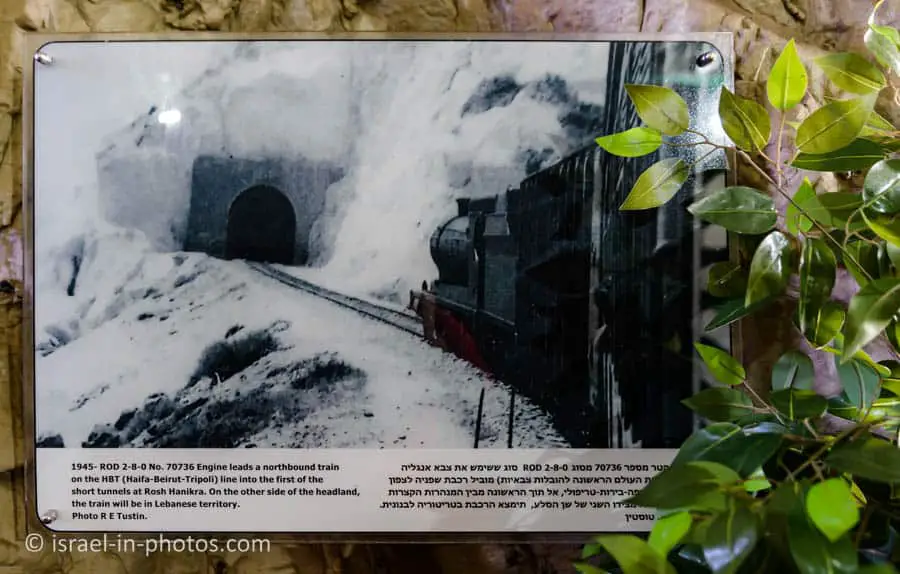
The Grottoes
Our next stop will be the grottoes.


Keep in mind that the stones might be wet and slippery. Thus, walk cautiously and use rails when needed.
The Big Grotto
When stormy, huge waves enter the grotto, pounding and powerful. They close off the opening, compressing the air within and causing momentary darkness… until the powerful breaking wave rocks the cliff foundation and partly floods the path before you. Grotto height – 16 meters. At its top live fruit bats, feeding off fragrant ripe fruit growing here. The bats live in colonies, enjoying a life expectancy of about twenty years. The fruit bat has good intact vision, and unlike widely believed, it doesn’t become entangled in people’s hair. On quiet days you can hear the bats screaming and chirping.
Source: sign
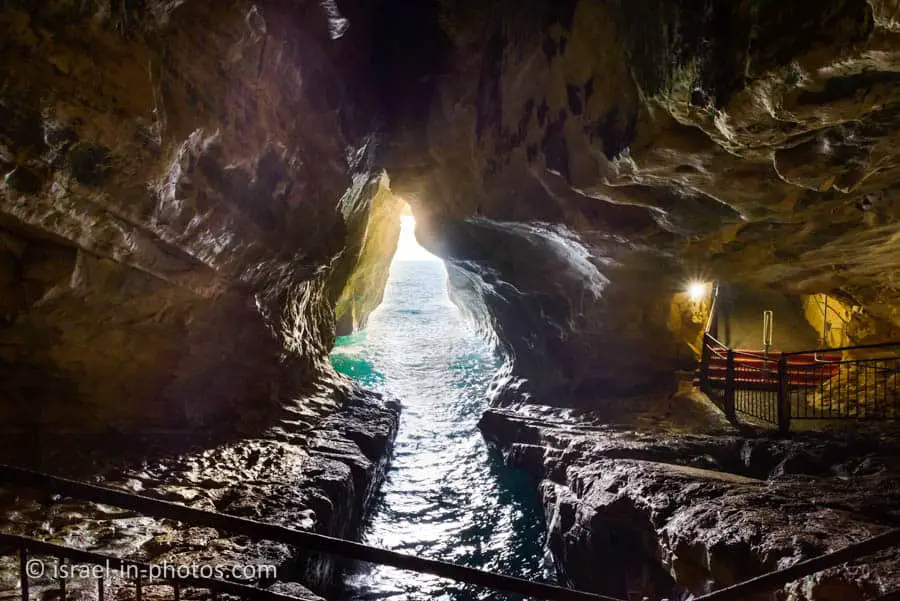


The path in the caves is not very long. It took us about fifteen minutes (including taking photos) to reach the pigeon bridge (the end of the underground route).
Pigeon Bridge – Lucky Bridge?
In the giant rock cleft above us, the rock pigeon makes its nest. The place provides a refuge from the weather, allowing it to nest in peace. Watch out for the pigeon’s droppings, but know this… It brings good luck!! From the observatory overlooking the sea, you can see the flat coarse sand rocks – the work of the sea waves and winds constantly polishing the rock surface smooth.
Source: sign
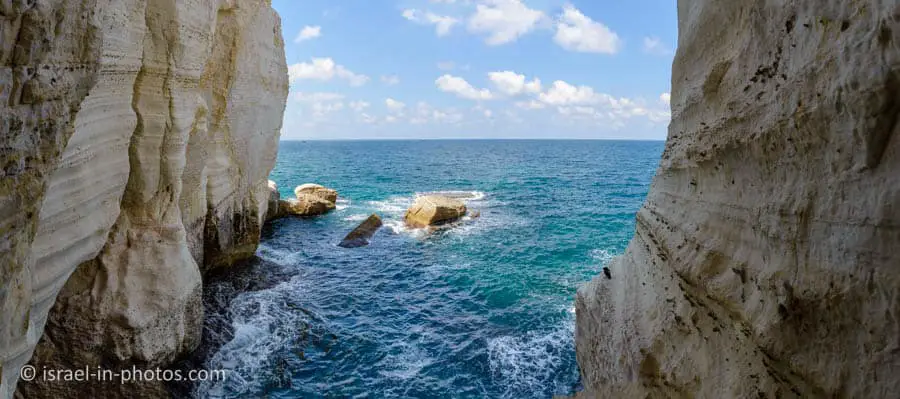
The Elephant’s Leg
Here is another scene of the white cliffs and the beach. If you look closer at the other ridge, you might think it resembles an elephant because the right part resembles a trunk or a leg. Thus, some people refer to this stone under the name elephant’s leg.

The never-ending encounter of sea and mountain created a natural stone sculpture shaped like an elephant leg. This is the edge of the cliff at the only point in Israel where the mountain descends into the sea without a sandy seashore. Glancing south, you can see the three islands. “Pale Blue” – mostly covered by water, “Seagull,” and “Wagtail.”
The islands have been declared a nature reserve, as birds nest there. Silver seagulls, sea terns, white wagtails. The islands are the peaks of the western coarse sand ridge of Galilee’s coastal plain. When visibility is good, you can even see Haifa and the Carmel. Looking north, you can see the border buoys marking the Israel-Lebanon border and the Israeli Navy vessels, permanently moored here and protecting the northern coastline.
Source: sign
The caves are beautiful, but the trail is not that long. The Grottoes loop path takes around half an hour at a slow pace.
Driving an Electric Golf Car at Rosh Hanikra Sea Reserve
You can use the lower entry/exit (reached through the former railway tunnel) to explore the Rosh Hanikra Sea Reserve.

On one of our visits, we purchased a combined ticket. The ticket included an entrance to Rosh HaNikra and an electric car ride along the Rosh Hanikra Sea Reserve beach.
The ride in the electric car was limited by time. We got the car for a half-hour. The beach is not that long, and I think the part closer to Rosh HaNikra is the lovelier one. Thus, due to the short time and no real reason to go further away, I recommend not purchasing the combined tickets, including the electric car or bicycle rental. We enjoyed the walk along the beach (after returning the electric car) more than the ride in the car.
Rock hyrax
Another pleasant surprise at Rosh Hanikra Sea Reserve was hyraxes.
Since we saw food remains on the rocks, we guessed somebody was feeding them. And there were dozens of rock hyraxes close to the lower entrance.
The water is crystal clear, and the rock formations are outstanding:

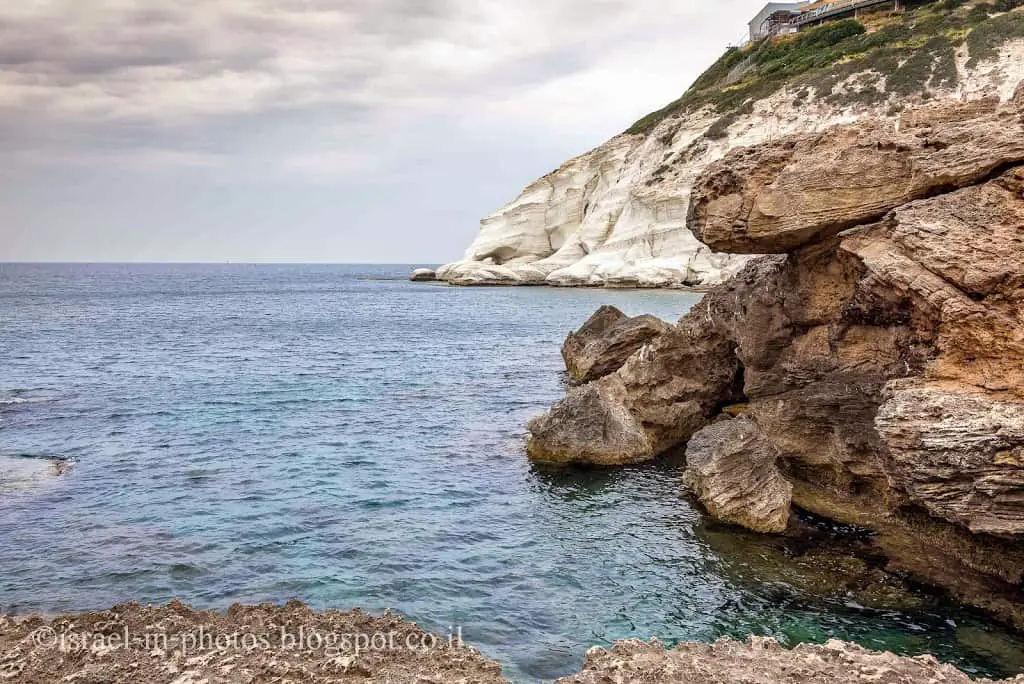
We ended our beach stroll, headed through the lower entrance, and back to the cable car. Also, when exiting Rosh HaNikra to the beach, ensure a staff member is putting a stamp on your hand. This way, you could reenter the site.

Kayaking at Rosh HaNikra
Different private firms offer Rosh HaNikra kayaking and sailing. Due to the closeness to the Lebanon border, such sails must be coordinated with the Israeli Navy. Thus, you can not kayak there by yourself.
I have not attended this activity yet, so I can not share my experience. However, if you are interested, here are several links to kayaking firms:
Rosh HaNikra Islands
Rosh HaNikra Islands are a group of four small islands in Achziv Nature Reserve. Due to their rich ecosystem, they cannot be visited.
The Rosh Hanikra Islands are part of an ancient coastline submerged by the sea. Only their peaks, a series of wind-blasted, perforated rocks – the largest of which is not much larger than the size of two tennis courts – are currently above sea level.
Nonetheless, they are home to a surprisingly rich eco-system, and as such are protected by the authorities.
Source: jpost.com
The Rosh HaNikra Islands are a group of three Israeli islands in the Mediterranean Sea, named Shahaf, Nahalieli, and T’chelet. The islands are located approximately 800 meters offshore, near Rosh HaNikra. These islands are a single geological unit with the Achziv Islands that are further south. The depth of the seawater around them is approximately between 7 and 9 meters. The Rosh HaNikra Islands are characterized by many natural pools that provide a natural habitat for various life forms.
The Rosh HaNikra Islands are a part of a natural reserve, and boarding these islands is prohibited. These islands are the only place in Israel where certain rare birds nest: the White wagtail, The European herring gull, and the Common tern. The waters surrounding these islands contain a wide variety of marine life.
In ancient days, these islands had a certain economic and commercial significance as they were a natural habitat for the sea snail from which Tyrian purple dye was produced.
Source: Wikipedia
And now, let’s revisit the beach during the golden hour.
Rosh Hanikra Sea Reserve
In this section, I will show several photos from my visit to the beach for a sunset shoot. The rock formations and the crystal blue water were the main reasons for returning.
Rosh Hanikra Sea Reserve has an open beach (the one near the lower entrance), and you can enter at any hour. But, since I mentioned it, here is some basic info:
Achziv National Park
Akhziv Beach National Park, located about five kilometers north of Nahariya, features a rocky shoreline, inlets, and lagoons, and a natural and an artificial sea-water pool–a deep one as well as a shallow one suitable for children. There are also broad lawns and antiquities. In short, everything you need to enjoy hours of Israeli sunshine.
Akhziv is unique for the sea anemones, sea urchins, and small octopi that can often be seen hiding among the rocks. And in July and August, the sea turtles that lay eggs on the beach. Small islands, where seagulls nest in summer, are nature reserves in their own right, remnants of once-landlocked calcareous limestone (kurkar) ridges. Remains can also be seen of the ancient settlement of Akhziv, mentioned in the Bible as a city of the tribe of Asher, and an essential Jewish town in Talmudic times. A mainstay of Akhziv’s ancient economy was the production of purple dye from particular snails collected on the beach.
In Crusader times Akhziv was called Castel Humbert, ruins of which can still be seen. In 1271 it was conquered by the Mamluk Sultan Baibars. Most of the remains you see today are from the abandoned Arab village of Az-Ziv.
Source: Israel Nature and Parks Authority
I have a dedicated post for this national park. And you can find additional information at Achziv National Park.
Photos of the Beach at Sunset
Last Friday, I was there during the golden hour, and today, I will show you several of my photos.
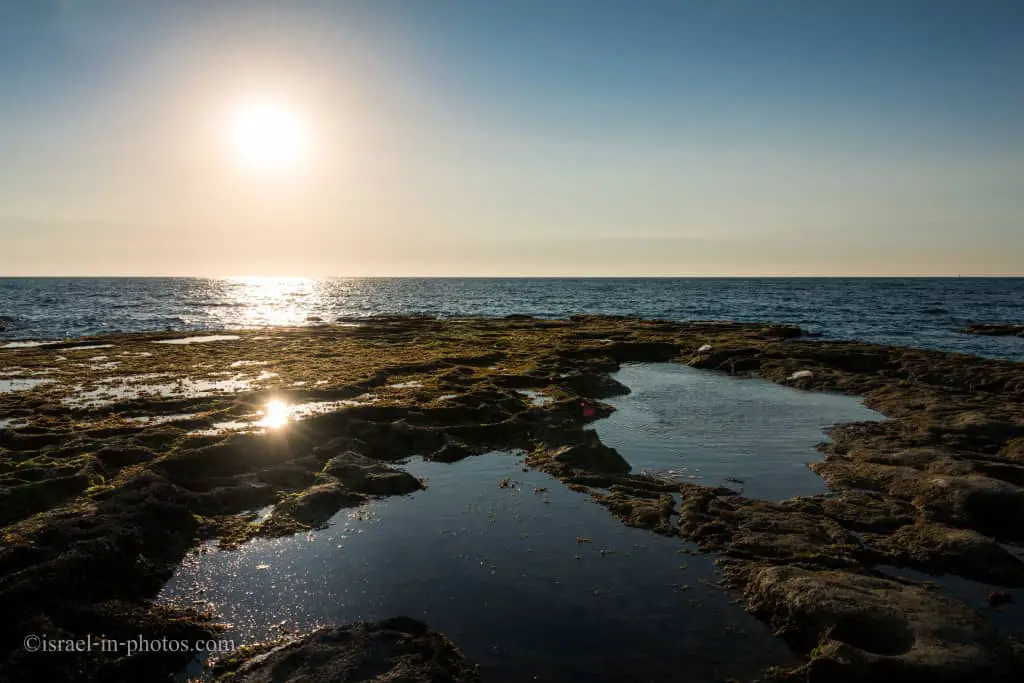
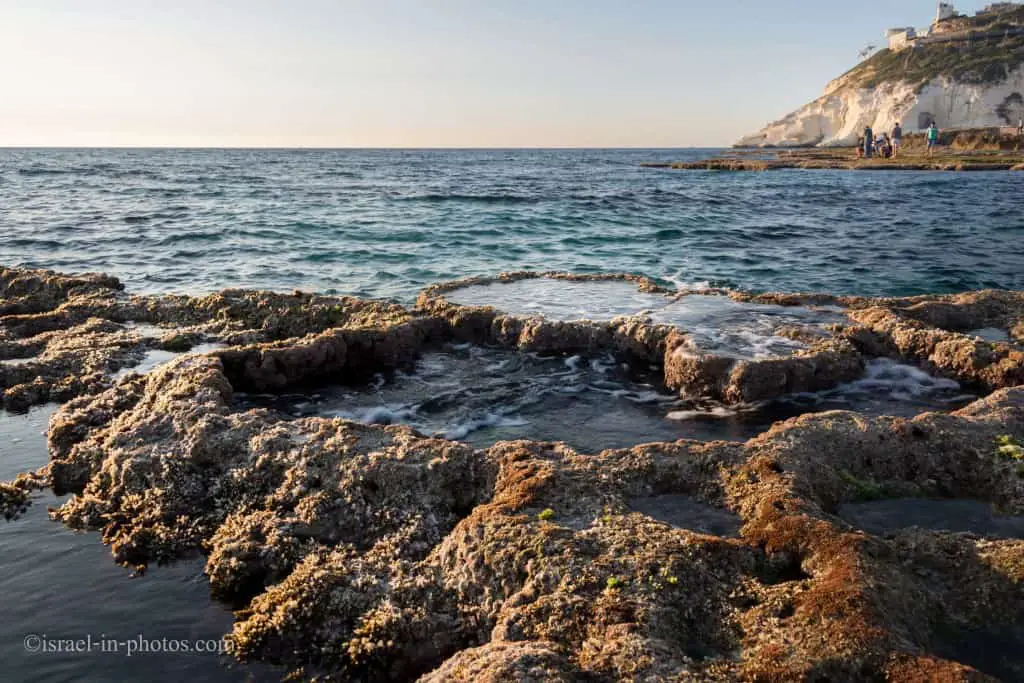


You can see military ships patrolling. That is because it is very close to the Lebanon border.

These small ponds or lagoons are gorgeous. And since they are directly connected to the sea, you can see small fish and lobsters if you stand there for a while. At least, that is what I saw.
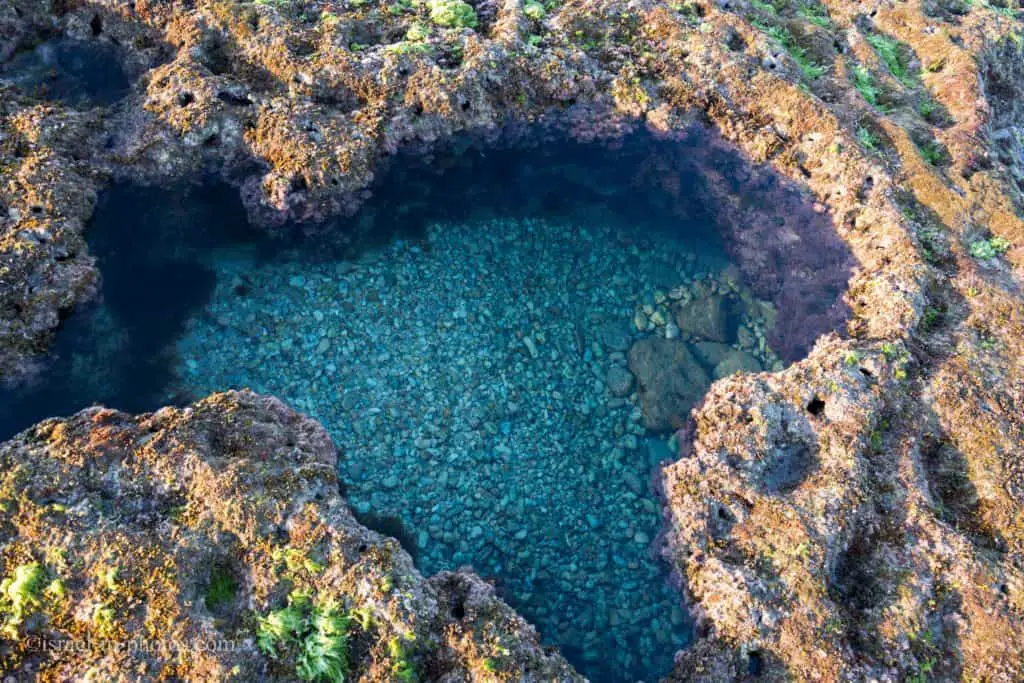
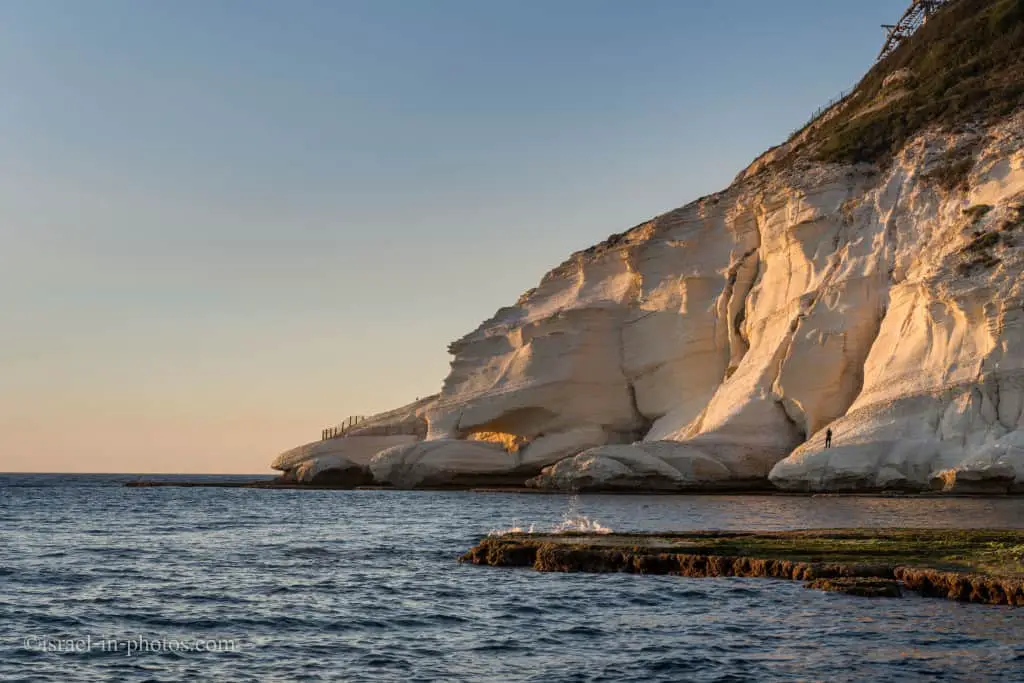
There were several anglers on the beach. The one close to me had two fishing rods. When I took this photo, the fisherman was at the other fishing rod:

Some rocks are covered with greenery, and they are very slippery.

Just after the sun sets is my favorite shooting time. The skies become more vibrant and exciting, and I get longer exposures, which means smoother water.

The fisherman decided to pose for me a little :)


To portray the feeling, the photo above is a 15-second exposure, and during those 15 seconds, the fisherman barely moved. So, I guess he also thought that it was a beautiful sunset.
Though the photos look pretty bright (due to the long exposures), it was already very dark, and I could not move without a flashlight.
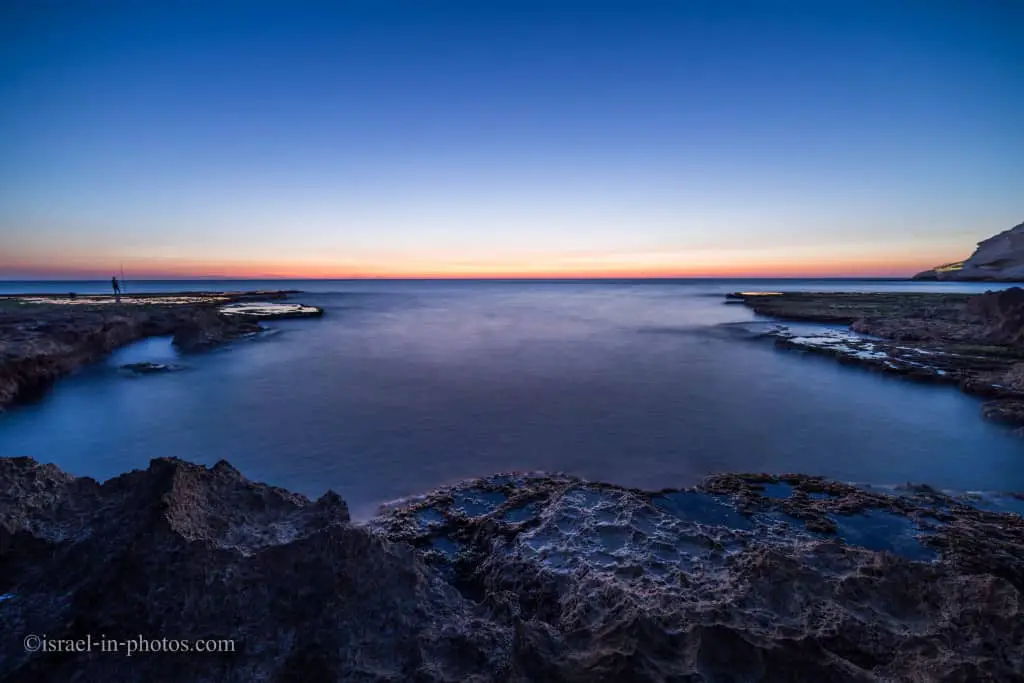

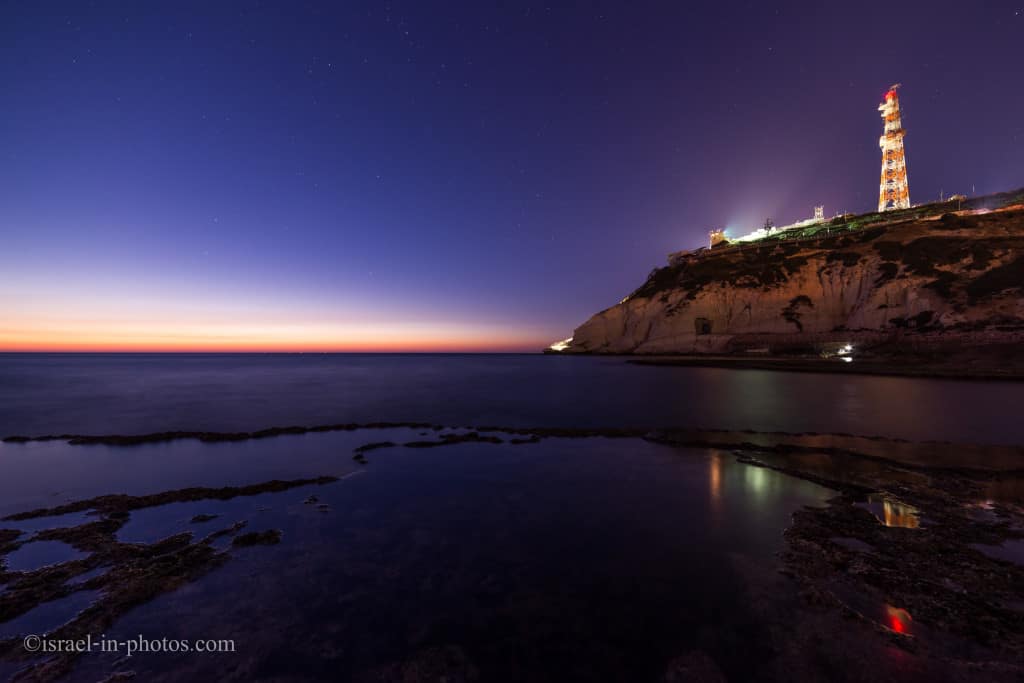
Rosh Hanikra Sea Reserve is quite far away from the big cities, and there is not a lot of light pollution (besides Haifa on the far left). Thus, you can see many stars:

This is a combo of two photos. One just as the sun reached the horizon and another well after the sunset (you can even notice some stars). It is my latest addition to the Day To Night.
Summary
Rosh HaNikra is gorgeous, and we have enjoyed all our visits. The site is not vast, and two hours will probably be enough to explore the grottoes and the lookout.
Because there are no limitations to the number of people that can visit this site at any point, during rush hours, you will spend a lot of time waiting (for the cable car, presentation, parking, and so on). Thus, I would advise coming early. The second best option is to visit later in the afternoon. And skip the golf cart and bicycles.
Since it is a relatively short attraction, you can combine it with other places in this area – for example, the beautiful nearby Achziv National Park or Keshet Cave. You can use the interactive map at the top of this post to find nearby attractions.
Have you ever visited Rosh HaNikra Grottoes? How was your experience? Tell us in the comments below.
That’s all for today, and I will see you in future travels!
Stay Tuned!
Additional Resources
Here are several resources that I created to help travelers:- Trip Planner with Attractions and Itineraries is the page that will help you create your perfect travel route.
- What is the Best Time to visit Israel? To answer this question, we will consider the weather, prices, holidays, festivals, and more.
- Information and Tips for Tourists to Israel will answer the most common questions tourists have about Israel (including safety, passports, weather, currency, tipping, electricity, and much more).
- Israel National Parks and Nature Reserves include a complete list, top ten, map, tickets (Israel Pass, Matmon, combo), and campsites.
- If you are looking for things to do, here are the pages for Jerusalem, Tel Aviv, Haifa, Sea Of Galilee, Akko (Acre), Eilat, Nazareth, Safed (Tzfat), and Makhtesh Ramon.

